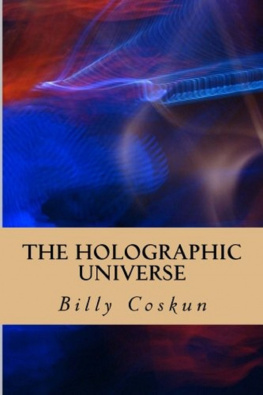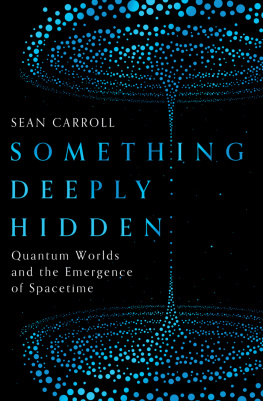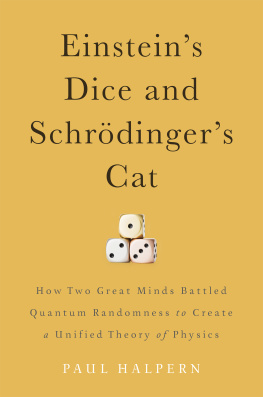Michael Talbot was born in Grand Rapids, Michigan, in 1953. He is the author of Mysticism and the New Physics, Beyond the Quantum and Your Past Lives: A Reincarnation Handbook, as well as three novels.
THE
HOLOGRAPHIC
UNIVERSE
MICHAEL TALBOT
HarperCollinsPublishes
HarperCollinsPublishes
77-85 Fulham Palace Road,
Hammersmith, London W6 8JB
This paperback edition 1996
Previously published by Grafton Books 1991
First published in Great Britain by
HarperCollinsPublishes
Copyright Michael Talbot 1991
The Author asserts the moral right to
be identified as the author of this work
ISBN 0 586 091718
Printed and bound in Great Britain by
Clays Lid, St Ives pic
All rights reserved. No part of this publication may be
reproduced, stored in a retrieval system, or transmitted,
in any form or by any means, electronic, mechanical,
photocopying, recording or otherwise, without the prior
permission of the publishers.
This book is sold subject to the condition that it shall not,
by way of trade or otherwise, be lent, re-sold, hired out or
otherwise circulated without the publisher's prior consent
in any form of binding or cover other than that in which it
is published and without a similar condition including this
condition being imposed on the subsequent purchaser.
For Alexandra, Chad, Ryan,
Larry Joe, and Shawn,
with love
The new data are of such far-reaching relevance that they could revolutionize our understanding of the human psyche, of psychopathology, and of the therapeutic process. Some of the observations transcend in their significance the framework of psychology and psychiatry and represent a serious challenge to the current Newtonian-Cartesian paradigm of Western science. They could change drastically our image of human nature, of culture and history, and of reality.
Dr. Stanislav Grof on
holographic phenomena in
The Adventure of Self-Discovery |
Contents
Acknowledgments
Writing is always a collaborative effort and many people have contributed to the production of this book in various ways. It is not possible to name them all, but a few who deserve special mention include:
David Bohm, Ph.D., and Karl Pribram, Ph.D., who were generous with both their time and their ideas, and without whose work this book would not have been written.
Barbara Brennan, M.S., Larry Dossey, M.D., Brenda Dunne, Ph.D., Elizabeth W. Fenske, Ph.D., Gordon Globus, Jim Gordon, Stanislav Grof, M.D., Francine Howland, M.D., Valerie Hunt, Ph.D., Robert Jahn, Ph.D., Ronald Wong Jue, Ph.D., Mary Orser, F. David Peat, Ph.D., Elizabeth Rauscher, Ph.D., Beatrice Rich, Peter M. Rojcewicz, Ph.D., Abner Shimony, PhD., Bernie S. Siegel, M.D., T.M. Srinivasan, M.D., Whitley Strieber, Russell Targ, William A. Tiller, Ph.D., Montague Ullman, M.D., Lyall Watson, Ph.D., Joel L. Whitton, M.D., Ph.D., Fred Alan Wolf, Ph.D., and Richard Zarro, who were also all generous with their time and ideas.
Carol Ann Dryer, for her friendship, insight, and support, and for unending generosity when it comes to sharing her profound talent.
Kenneth Ring, Ph.D., for hours of fascinating conversation and for introducing me to the writings of Henry Corbin.
Stanley Krippner, Ph.D., for taking the time to call me or drop me a note whenever he came across any new leads on the holographic idea.
Terry Oleson, Ph.D., for his time and for kindly allowing me to use his diagram of the little man in the ear.
Michael Grosso, Ph.D., for thought-provoking conversation and for helping me track down several obscure reference works on miracles.
Brendan O'Regan of the Institute of Noetic Sciences, for his important contributions to the subject of miracles and for helping me track down information on the same.
My longtime friend Peter Brunjes, Ph.D., for using his university connections to help me obtain several difficult-to-find reference works.
Judith Hooper, for loaning me numerous books and articles from her own extensive collection of materials on the holographic idea.
Susan Cowles, M.S., of the Museum of Holography in New York for helping me search out illustrations for the book.
Kerry Brace, for sharing his thoughts on the holographic idea as it applies to Hindu thinking, and from whose writings I have borrowed the idea of using the hologram of Princess Leia from the movie Star Wars to open the book.
Marilyn Ferguson, the founder of the Brain/Mind Bulletin, who was one of the first writers to recognize and write about the importance of the holographic theory, and who also was generous with her time and thought. The observant reader will notice that my summary of the view of the universe that arises when one considers Bohm and Pribram's conclusions in tandem, at the end of Chapter Two, is actually just a slight rephrasing of the words Ferguson uses to summarize the same sentiment in her bestselling book The Aquarian Conspiracy. My inability to come up with a different and better way to summarize the holographic idea should be viewed as a testament to Ferguson's clarity and succinctness as a writer.
The staff at the American Society for Psychical Research for assistance in tracking down references, resources, and the names of pertinent individuals.
Martha Visser and Sharon Schuyler for their help in researching the book.
Ross Wetzsteon of the Village Voice, who asked me to write the article that started it all.
Claire Zion of Simon & Schuster, who first suggested that I write a book on the holographic idea.
Lucy Kroll and Barbara Hogenson for being the best agents possible.
Lawrence P. Ashmead of HarperCollins for believing in the book, and John Michel for his gentle and insightful editing.
If there is anyone that I have inadvertently left out, please forgive me. To all, both named and unnamed, who have helped me give birth to this book, my heartfelt thanks.
Introduction
In the movie Star Wars, Luke Skywalker's adventure begins when a beam of light shoots out of the robot Artoo Detoo and projects a miniature three-dimensional image of Princess Leia. Luke watches spellbound as the ghostly sculpture of light begs for someone named Obi-wan Kenobi to come to her assistance. The image is a hologram, a three-dimensional picture made with the aid of a laser, and the technological magic required to make such images is remarkable. But what is even more astounding is that some scientists are beginning to believe the universe itself is a kind of giant hologram, a splendidly detailed illusion no more or less real than the image of Princess Leia that starts Luke on his quest.
Put another way, there is evidence to suggest that our world and everything in itfrom snowflakes to maple trees to falling stars and spinning electronsare also only ghostly images, projections from a level of reality so beyond our own it is literally beyond both space and time.
The main architects of this astonishing idea are two of the world's most eminent thinkers: University of London physicist David Bohm, a protege of Einstein's and one of the world's most respected quantum physicists; and Karl Pribram, a neurophysiologist at Stanford University and author of the classic neuropsychological textbook Languages of the Brain.












